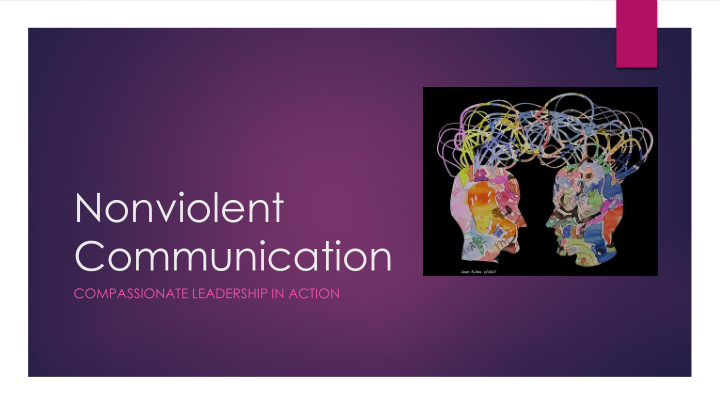



Nonviolent Communication COMPASSIONATE LEADERSHIP IN ACTION
Why Nonviolent Communication? We are culturally habituated to focus our attention on judgement, blame and diagnosis of self and others, especially when in CONFLICT. A simple, profound and learnable process that trains us to focus on the powerful human needs that are the motivation for everything we do and say. Respect Understanding Safety When we focus our awareness on our own and others’ needs, it facilitates deep understanding of self and others. Communicating from this place opens up possibilities for flexible and creative solutions to even the most entrenched conflicts.
NVC Assumptions All human beings have the capacity for compassion & only resort to violence or behavior that harms others when they don’t recognize more effective strategies for meeting needs. All human behavior stems from attempts to meet universal human needs & that these needs are never in conflict. Conflict arises when strategies for meeting needs clash. If people can identify their needs, the needs of others, & the feelings that surround these needs, harmony can be achieved.
A Conflict Resolution Process Based on three aspects of communication: self-empathy (defined as a deep & compassionate awareness of one’s own inner experience) empathy (defined as listening to another with deep compassion), and honest self-expression (defined as expressing oneself authentically in a way that is likely to inspire compassion in others)
The Tree of Life: Options for Connection “I use the term Nonviolent Communication™ as Gandhi used it – to refer to our natural state of compassion when violence has subsided from our heart. While we may not believe we are ‘violent’, our words and thoughts often lead to pain for others and ourselves.” - Dr Marshall Rosenberg
The Process “At the root of every tantrum and power struggle are unmet needs .” -Dr Marshall Rosenberg
What You Do State concrete actions you observe in yourself or the other person. State the feeling that the observation is triggering in you. Or, guess what the other person is feeling, and ask. State the need that is the cause of that feeling. Or, guess the need that caused the feeling in the other person, and ask. Make a concrete request for action to meet the need just identified.
Yes, there’s an APP for that.
The Uses of NVC Self empowerment Understanding others Conflict resolution Stress reduction Bridging cultural differences Harmonious relationships
NVC as Spiritual Practice Central purpose to connect with oneself, other human beings, and the divine. Once we connect with needs of others in open-hearted way, our common humanity is fundamental point of connection. Even if we don’t agree, we can understand and acknowledge their hearts’ longing. Jesus Christ reveals not only true God but true humanity. He shows us what our created existence was meant to be – a human being for and with others because self-giving love marks his entire life. God is for us as a savior and with us as fellow sufferer. Thus we live out the human interconnectedness for which we were created. “Rejoice with those who rejoice, weep with those who weep.” – Romans 12:15; “Bear one another’s burdens, and in this way, you will fulfill the Law of Christ.” – Galations 6:2
Resources
NVC in Action Exercises
Recommend
More recommend